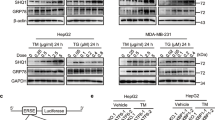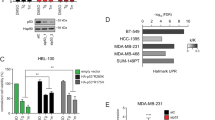Abstract
Targeted therapeutic options and prognostic biomarkers for hormone receptor- or Her2 receptor-negative breast cancers are severely limited. The sigma-1 receptor, a stress-activated chaperone, is frequently dysregulated in disease. However, its significance in breast cancer (BCa) has not been adequately explored. Here, we report that the sigma-1 receptor gene (SIGMAR1) is elevated in BCa, particularly in the aggressive triple-negative (TNBC) subtype. By examining several patient datasets, we found that high expression at both the gene (SIGMAR1) and protein (Sig1R) levels associated with poor survival outcomes, specifically in ER-Her2- groups. Our data further show that high SIGMAR1 was predictive of shorter survival times in patients treated with adjuvant chemotherapy (ChT). Interestingly, in a separate cohort who received neoadjuvant taxane + anthracycline treatment, elevated SIGMAR1 associated with higher rates of pathologic complete response (pCR). Treatment with a Sig1R antagonist, 1-(4-iodophenyl)-3-(2-adamantyl)guanidine (IPAG), activated the unfolded protein response (UPR) in TNBC (high-Sig1R expressing) and ER + (low-Sig1R expressing) BCa cell lines. In tamoxifen-resistant LY2 cells, IPAG caused Sig1R to aggregate and co-localise with the stress marker BiP. These findings showcase the potential of Sig1R as a novel biomarker in TNBC as well as highlight its ligand-induced interference with the stress-coping mechanisms of BCa cells.
This is a preview of subscription content, access via your institution
Access options
Subscribe to this journal
Receive 12 print issues and online access
$259.00 per year
only $21.58 per issue
Buy this article
- Purchase on Springer Link
- Instant access to full article PDF
Prices may be subject to local taxes which are calculated during checkout



Similar content being viewed by others
Data availability
The datasets analysed in this study are available at publicly accessible online repositories.
Change history
21 December 2022
A Correction to this paper has been published: https://doi.org/10.1038/s41417-022-00579-7
References
Cardoso F, Kyriakides S, Ohno S, Penault-Llorca F, Poortmans P, Rubio IT, et al. Early breast cancer: ESMO Clinical Practice Guidelines for diagnosis, treatment and follow-up. Ann Oncol. 2019;30:1674.
Park YH, Lee SJ, Cho EY, Choi Y, Lee JE, Nam SJ, et al. Clinical relevance of TNM staging system according to breast cancer subtypes. Ann Oncol. 2011;22:1554–60.
Rakha EA, Reis-Filho JS, Baehner F, Dabbs DJ, Decker T, Eusebi V, et al. Breast cancer prognostic classification in the molecular era: the role of histological grade. Breast Cancer Res. 2010;12:207.
Harbeck N, Penault-Llorca F, Cortes J, Gnant M, Houssami N, Poortmans P, et al. Breast cancer. Nat Rev Dis Prim. 2019;5:66.
Bauer KR, Brown M, Cress RD, Parise CA, Caggiano V. Descriptive analysis of estrogen receptor (ER)-negative, progesterone receptor (PR)-negative, and HER2-negative invasive breast cancer, the so-called triple-negative phenotype. Cancer 2007;109:1721–8.
Liedtke C, Mazouni C, Hess KR, Andre F, Tordai A, Mejia JA, et al. Response to neoadjuvant therapy and long-term survival in patients with triple-negative breast cancer. J Clin Oncol. 2008;26:1275–81.
Lehmann BD, Bauer JA, Chen X, Sanders ME, Chakravarthy AB, Shyr Y, et al. Identification of human triple-negative breast cancer subtypes and preclinical models for selection of targeted therapies. J Clin Invest. 2011;121:2750–67.
Peto R, Davies C, Godwin J, Gray R, Pan HC, Clarke M, et al. Comparisons between different polychemotherapy regimens for early breast cancer: meta-analyses of long-term outcome among 100,000 women in 123 randomised trials. Lancet 2012;379:432–44.
Weigelt B, Baehner FL, Reis-Filho JS. The contribution of gene expression profiling to breast cancer classification, prognostication and prediction: a retrospective of the last decade. J Pathol. 2010;220:263–80.
Minckwitz GV, Mueller B, Blohmer JU, Kaufmann M, Eidtmann H, Eiermann W, et al. Prognostic and predictive impact of Ki-67 before and after neoadjuvant chemotherapy on PCR and survival: results of the GeparTrio trial. J Clin Oncol. 2012;30:1023.
Hayashi T, Su TP. Sigma-1 receptor chaperones at the ER-mitochondrion interface regulate Ca(2+) signaling and cell survival. Cell 2007;131:596–610.
Mori T, Hayashi T, Hayashi E, Su TP. Sigma-1 receptor chaperone at the ER-mitochondrion interface mediates the mitochondrion-ER-nucleus signaling for cellular survival. PLoS ONE. 2013;8:e76941.
Su TP, Su TC, Nakamura Y, Tsai SY. The Sigma-1 receptor as a pluripotent modulator in living systems. Trends Pharmacol Sci. 2016;37:262–78.
Hetz CA, Soto C. Stressing out the EIR: a role of the unfolded protein response in prion-related disorders. Curr Mol Med. 2006;6:37–43.
Hetz C, Axten JM, Patterson JB. Pharmacological targeting of the unfolded protein response for disease intervention. Nat Chem Biol. 2019;15:764–75.
Clarke R, Shajahan AN, Wang Y, Tyson JJ, Riggins RB, Weiner LM, et al. Endoplasmic reticulum stress, the unfolded protein response, and gene network modeling in antiestrogen resistant breast cancer. Horm Mol Biol Clin Investig. 2011;5:35–44.
Clarke R, Cook KL, Hu R, Facey CO, Tavassoly I, Schwartz JL, et al. Endoplasmic reticulum stress, the unfolded protein response, autophagy, and the integrated regulation of breast cancer cell fate. Cancer Res. 2012;72:1321–31.
Chen X, Iliopoulos D, Zhang Q, Tang Q, Greenblatt MB, Hatziapostolou M, et al. XBP1 promotes triple-negative breast cancer by controlling the HIF1α pathway. Nature 2014;508:103–7.
Hu R, Warri A, Jin L, Zwart A, Riggins RB, Fang HB, et al. NF-κB signaling is required for XBP1 (unspliced and spliced)-mediated effects on antiestrogen responsiveness and cell fate decisions in breast cancer. Mol Cell Biol. 2015;35:379–90.
Davies MP, Barraclough DL, Stewart C, Joyce KA, Eccles RM, Barraclough R, et al. Expression and splicing of the unfolded protein response gene XBP-1 are significantly associated with clinical outcome of endocrine-treated breast cancer. Int J Cancer. 2008;123:85–8.
Spruce BA, Campbell LA, McTavish N, Cooper MA, Appleyard MVL, O’Neill M, et al. Small molecule antagonists of the sigma-1 receptor cause selective release of the death program in tumor and self-reliant cells and inhibit tumor growth in vitro and in vivo. Cancer Res. 2004;64:4875–86.
Oyer HM, Sanders CM, Kim FJ. Small-molecule modulators of sigma1 and sigma2/TMEM97 in the context of cancer: foundational concepts and emerging themes. Front Pharmacol. 2019;10:1141.
Xu Q-X, Li E-M, Zhang Y-F, Liao L-D, Xu X-E, Wu Z-Y, et al. Overexpression of Sigma1 receptor and its positive associations with pathologic TNM classification in esophageal squamous cell carcinoma. J Histochem Cytochem. 2012;60:457–66.
Gueguinou M, Crottès D, Chantôme A, Rapetti-Mauss R, Potier-Cartereau M, Clarysse L, et al. The SigmaR1 chaperone drives breast and colorectal cancer cell migration by tuning SK3-dependent Ca(2+) homeostasis. Oncogene 2017;36:3640–7.
Schrock JM, Spino CM, Longen CG, Stabler SM, Marino JC, Pasternak GW, et al. Sequential cytoprotective responses to sigma1 ligand–induced endoplasmic reticulum stress. Mol Pharmacol. 2013;84:751–62.
Thomas JD, Longen CG, Oyer HM, Chen N, Maher CM, Salvino JM, et al. Sigma1 targeting to suppress aberrant androgen receptor signaling in prostate cancer. Cancer Res. 2017;77:2439–52.
Hess KR, Anderson K, Symmans WF, Valero V, Ibrahim N, Mejia JA, et al. Pharmacogenomic predictor of sensitivity to preoperative chemotherapy with paclitaxel and fluorouracil, doxorubicin, and cyclophosphamide in breast cancer. J Clin Oncol. 2006;24:4236–44.
Charmsaz S, Hughes É, Bane FT, Tibbitts P, McIlroy M, Byrne C, et al. S100β as a serum marker in endocrine resistant breast cancer. BMC Med. 2017;15:79.
Bronzert DA, Greene GL, Lippman ME. Selection and characterization of a breast cancer cell line resistant to the antiestrogen LY 117018. Endocrinology 1985;117:1409–17.
Manders EMM, Verbeek FJ, Aten JA. Measurement of co-localization of objects in dual-colour confocal images. J Microsc. 1993;169:375–82.
Wang B, Rouzier R, Albarracin CT, Sahin A, Wagner P, Yang Y, et al. Expression of sigma 1 receptor in human breast cancer. Breast Cancer Res Treat. 2004;87:205–14.
Govindan S, Siraganahalli Eswaraiah M, Basavaraj C, Adinarayan M, Sankaran S, Bakre M. Androgen Receptor mRNA levels determine the prognosis in triple-negative breast cancer patients. BMC Cancer. 2020;20:745.
Liu J, Lichtenberg T, Hoadley KA, Poisson LM, Lazar AJ, Cherniack AD, et al. An integrated TCGA pan-cancer clinical data resource to drive high-quality survival outcome analytics. Cell 2018;173:400–16. e11
Simony-Lafontaine J, Esslimani M, Bribes E, Gourgou S, Lequeux N, Lavail R, et al. Immunocytochemical assessment of sigma-1 receptor and human sterol isomerase in breast cancer and their relationship with a series of prognostic factors. Br J Cancer. 2000;82:1958–66.
Jbilo O, Vidal H, Paul R, De Nys N, Bensaid M, Silve S, et al. Purification and characterization of the human SR 31747A-binding protein. A nuclear membrane protein related to yeast sterol isomerase. J Biol Chem. 1997;272:27107–15.
Lee E, Nichols P, Groshen S, Spicer D, Lee AS. GRP78 as potential predictor for breast cancer response to adjuvant taxane therapy. Int J Cancer. 2011;128:726–31.
Lee E, Nichols P, Spicer D, Groshen S, Yu MC, Lee AS. GRP78 as a novel predictor of responsiveness to chemotherapy in breast cancer. Cancer Res. 2006;66:7849–53.
Sørlie T, Perou CM, Tibshirani R, Aas T, Geisler S, Johnsen H, et al. Gene expression patterns of breast carcinomas distinguish tumor subclasses with clinical implications. Proc Natl Acad Sci USA. 2001;98:10869.
Dreser A, Vollrath JT, Sechi A, Johann S, Roos A, Yamoah A, et al. The ALS-linked E102Q mutation in Sigma receptor-1 leads to ER stress-mediated defects in protein homeostasis and dysregulation of RNA-binding proteins. Cell Death Differ. 2017;24:1655–71.
La X, Zhang L, Li H, Li Z, Song G, Yang P, et al. Ajuba receptor mediates the internalization of tumor-secreted GRP78 into macrophages through different endocytosis pathways. Oncotarget 2018;9:15464–79.
Li R, Yanjiao G, Wubin H, Yue W, Jianhua H, Huachuan Z, et al. Secreted GRP78 activates EGFR-SRC-STAT3 signaling and confers the resistance to sorafeinib in HCC cells. Oncotarget 2017;8:19354–64.
Crouzier L, Denus M, Richard EM, Tavernier A, Diez C, Cubedo N, et al. Sigma-1 receptor is critical for mitochondrial activity and unfolded protein response in larval zebrafish. Int J Mol Sci. 2021;22:11049.
Oflaz FE, Koshenov Z, Hirtl M, Rost R, Malli R, Graier WF. Sigma-1 receptor modulation by ligands coordinates cancer cell energy metabolism. Biomolecules. 2022;12:762.
Farhadi P, Yarani R, Valipour E, Kiani S, Hoseinkhani Z, Mansouri K. Cell line-directed breast cancer research based on glucose metabolism status. Biomed Pharmacother. 2022;146:112526.
Acknowledgements
We gratefully acknowledge the contributions of Dr Katherine Sheehan and Joanna Fay at Beaumont Hospital, Dublin for carrying out the IHC staining. We thank Dr Sheehan and Fiona Bane (RCSI Dublin) for helping to score the TMA. This work was funded by the Dilmun Scholar Programme, RCSI-Bahrain.
Author information
Authors and Affiliations
Contributions
PB, STS and LY designed the study. PB performed the in vitro experiments and generated the figures. PB and NC acquired, analysed and interpreted in silico data, PB generated the figures. SC generated the IHC related results and graphs. STS and LY supervised the research. PB wrote the manuscript. PB, NC, STS and LY provided feedback on the manuscript.
Corresponding author
Ethics declarations
Competing interests
The authors declare no competing interests.
Additional information
Publisher’s note Springer Nature remains neutral with regard to jurisdictional claims in published maps and institutional affiliations.
Rights and permissions
Springer Nature or its licensor (e.g. a society or other partner) holds exclusive rights to this article under a publishing agreement with the author(s) or other rightsholder(s); author self-archiving of the accepted manuscript version of this article is solely governed by the terms of such publishing agreement and applicable law.
About this article
Cite this article
Borde, P., Cosgrove, N., Charmsaz, S. et al. An investigation of Sigma-1 receptor expression and ligand-induced endoplasmic reticulum stress in breast cancer. Cancer Gene Ther 30, 368–374 (2023). https://doi.org/10.1038/s41417-022-00552-4
Received:
Revised:
Accepted:
Published:
Issue Date:
DOI: https://doi.org/10.1038/s41417-022-00552-4
This article is cited by
-
Blocking SIG1R Along with Low Cadmium Exposure Display Anti-cancer Qualities in Both MCF7 and MDA-MB-231 Cells
Biological Trace Element Research (2023)
-
Targeting Sigma Receptors for the Treatment of Neurodegenerative and Neurodevelopmental Disorders
CNS Drugs (2023)



